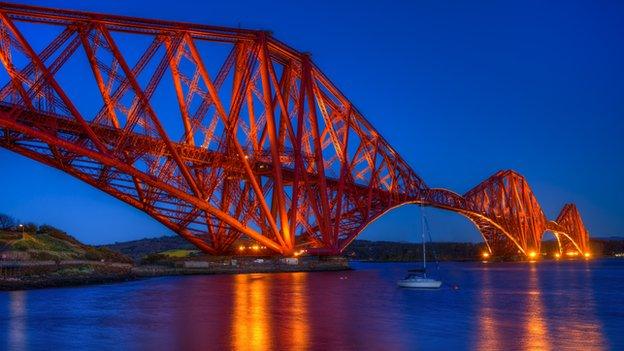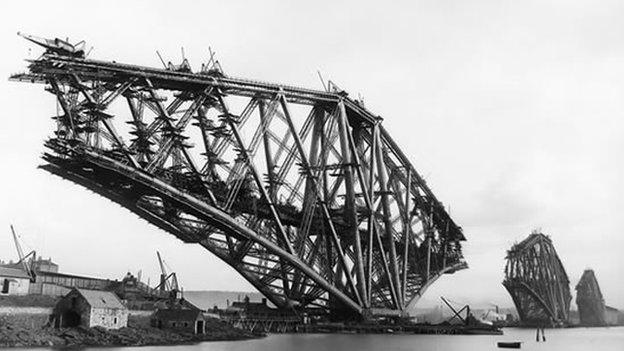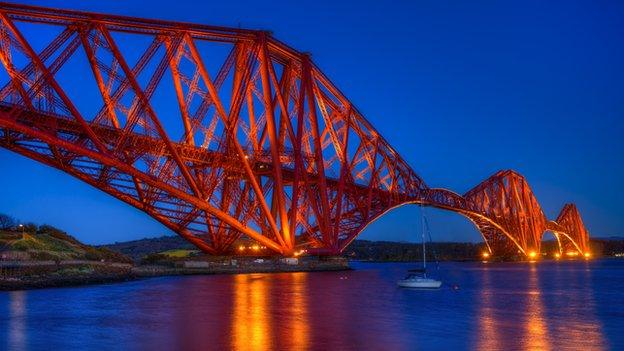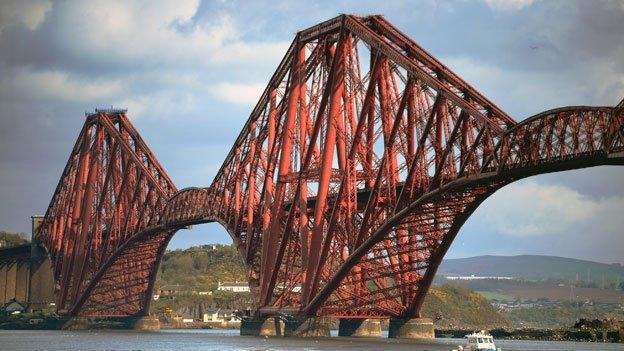Forth Bridge plaque marks world heritage status
- Published

Transport Minister Humza Yousaf unveiled the Forth Bridge plaque
A plaque has been unveiled marking the Forth Bridge as a United Nations world heritage site.
The distinctive red bridge, which opened in 1890, now has the same status as the Taj Mahal, the Great Wall of China and the Sydney Opera House.
The Unesco status was awarded in 2015, recognising the railway bridge as a feat of engineering.
The decision was announced at a meeting in Germany after the nomination was considered for more than a year.
World heritage status is given to sites of "outstanding universal value" with the aim of protecting them for future generations.
Tourist attraction
Transport Minister Humza Yousaf, who unveiled the plaque, said: "I'm unveiling the Unesco world heritage inscription that was received back in 2015.
"Today is definitely the right day to unveil that of course, because we have the Queensferry Crossing in less than a couple of weeks. That just adds, again, to the iconic nature of the bridges.
"People of course want to come down and see it as a tourist attraction, now knowing it's a world heritage site, I think that will attract even more people to come and see it."
The bridge was opened in 1890, weighs 53,000 tonnes and spans 1.5 miles, as Steven Godden reports
Malcolm Roughead, chief executive of VisitScotland, said: "The Forth Bridge is one of the world's most instantly recognisable bridges and a true marvel of Scottish engineering.
"It was fantastic to see it awarded world heritage status and this plaque is an excellent commemoration for all the hard work put in to achieve this."
The bridge, which spans the Firth of Forth between South Queensferry on the outskirts of Edinburgh and North Queensferry in Fife, took eight years to build.
Designed by Sir John Fowler and Benjamin Baker, it measures 2,529m (1.5 miles), weighs 53,000 tonnes and was, at the time, the world's longest multi-span cantilever bridge.
When it was constructed it was one of the most ambitious projects of its kind ever attempted, and at its peak, more than 4,500 men were employed building it.

The bridge was opened in 1890, weighs 53,000 tonnes and spans 1.5 miles
The Unesco inspection report stated: "This enormous structure, with its distinctive industrial aesthetic and striking red colour, was conceived and built using advanced civil engineering design principles and construction methods.
"Innovative in design, materials and scale, the Forth Bridge is an extraordinary and impressive milestone in bridge design and construction during the period when railways came to dominate long-distance land travel."
The bridge was the sixth Scottish landmark to be awarded world heritage status.
The other sites are New Lanark, St Kilda, the Old and New Towns in Edinburgh, Neolithic Orkney and the Antonine Wall.
New crossing
The Queensferry Crossing will open to traffic on Wednesday 30 August with an initial 40mph limit.
This is to allow work to take place on the Forth Road Bridge to complete its transformation into an active travel corridor.
When the work is complete, public transport will be switched on to the Forth Road Bridge and the Queensferry Crossing will be given motorway status.
Mr Yousaf added: "All three bridges have their own unique, iconic nature.
"I was recently overseas, I had a holiday away, and I was looking at some of the bridges where I was in Istanbul and I have to say, the bridges here: nobody can hold a candle to them."


The bridge took eight years to construct
Facts, figures and photos
For 125 years it has been an icon of Victorian engineering excellence, a symbol of Scotland and even a favourite expression for a never-ending task.
Now the Forth Bridge is listed alongside the Pyramids of Egypt, the great Wall of China and the Sydney Opera House in terms of cultural significance.
We've brought together some facts and figures - and more great pictures - of one of Britain's best-known structures, which you can see here.
- Published5 July 2015

- Published6 July 2015

- Published4 March 2015
